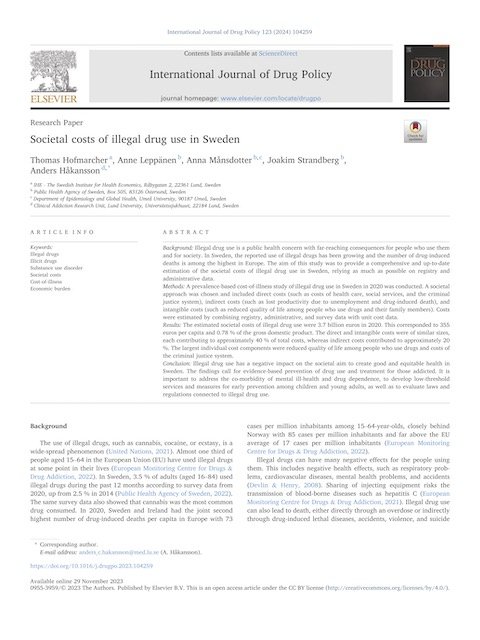By Thomas Hofmarcher, Anne Leppänen, Anna Månsdotter, Joakim Strandberg, Anders Håkansson
Background: Illegal drug use is a public health concern with far-reaching consequences for people who use them and for society. In Sweden, the reported use of illegal drugs has been growing and the number of drug-induced deaths is among the highest in Europe. The aim of this study was to provide a comprehensive and up-to-date estimation of the societal costs of illegal drug use in Sweden, relying as much as possible on registry and administrative data. Methods: A prevalence-based cost-of-illness study of illegal drug use in Sweden in 2020 was conducted. A societal approach was chosen and included direct costs (such as costs of health care, social services, and the criminal justice system), indirect costs (such as lost productivity due to unemployment and drug-induced death), and intangible costs (such as reduced quality of life among people who use drugs and their family members). Costs were estimated by combining registry, administrative, and survey data with unit cost data. Results: The estimated societal costs of illegal drug use were 3.7 billion euros in 2020. This corresponded to 355 euros per capita and 0.78 % of the gross domestic product. The direct and intangible costs were of similar sizes, each contributing to approximately 40 % of total costs, whereas indirect costs contributed to approximately 20 %. The largest individual cost components were reduced quality of life among people who use drugs and costs of the criminal justice system. Conclusion: Illegal drug use has a negative impact on the societal aim to create good and equitable health in Sweden. The findings call for evidence-based prevention of drug use and treatment for those addicted. It is important to address the co-morbidity of mental ill-health and drug dependence, to develop low-threshold services and measures for early prevention among children and young adults, as well as to evaluate laws and regulations connected to illegal drug use.
International Journal of Drug Policy, Volume 123, January 2024, 104259







